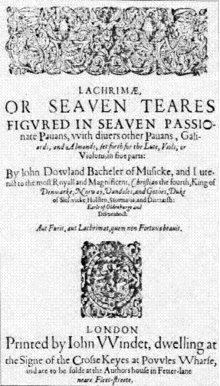Lachrimae, or Seaven Teares
Lachrimæ or seaven teares figured in seaven passionate pavans, with divers other pavans, galliards and allemands, set forth for the lute, viols, or violons, in five parts is a collection of instrumental music composed by John Dowland. It was published by John Windet in 1604.

From 1598 Dowland was employed as lutenist to Christian IV of Denmark, but he still published in London. The book was dedicated to Anne of Denmark, and Dowland mentions meeting her at Winchester, which suggests his involvement in her October 1603 masque, Prince Henry's Welcome at Winchester.[1][2]
The title page of Lachrimæ is adorned with a Latin epigram: "Aut Furit, aut Lachrimat, quem non Fortuna beavit" ("He whom Fortune has not blessed either rages or weeps"). Dowland points out in his dedication that there are different types of tears. “The teares which Musicke weeps” can be pleasant; “neither are teares shed always in sorrow but sometime in joy and gladnesse”.
Instrumentation
As the title suggests, the music is scored for five viols, or violins (that is, members of the violin family) and lute.
Lachrimae pavans
The seven pavans are variations on a theme, the "Lachrimæ pavan", which Dowland had already made well known as a lute solo and a song. (That pavan was reworked into the song "Flow my tears" in Dowland's Second Book of Songs (1600)[3] and begins with a "falling tear" motif of four notes.) The harmonies of the seven are intense, with lines weaving close together. Each was given a title by the composer, and there has been speculation that the group forms a narrative or musical journey, though any meaning remains unclear:
- Lachrimæ antiquae (Old Tears) — already existed as a lute solo and a song
- Lachrimæ antiquae novæ (Old Tears Renewed) — a harmonic parody of Lachrimæ antiquæ
- Lachrimæ gementes (Sighing Tears)
- Lachrimæ tristes (Sad Tears)
- Lachrimæ coactae (Forced Tears) — a harmonic parody of Lachrimæ tristes
- Lachrimæ amantis (A Lover’s Tears)
- Lachrimæ veræ (True Tears)
Other compositions
The “divers other” compositions are: two allemandes (“almands”), nine lively galliards (“galiards”), two sombre pavans, and a “funerall.” They are dedicated to people of varying social rank, including a pirate, Digorie Piper, who is not fully named.[4] “M” is mister, “Mss” is mistress. Still the scoring is for lute and 5 viols (or violins):
- Pavan “Semper Dowland semper Dolens” P9
- “Sir Henry Umptons Funerall” [sic]
- “M John Langtons Pavan” [sic] P14
- “The King of Denmarks Galiard” [sic] P40
- “The Earle of Essex Galiard” [sic] P42, dedicated to Robert Devereux, 2nd Earl of Essex
- “Sir John Souch his Galiard” [sic] P26
- “M Henry Noell his Galiard” [sic] P34
- “M Giles Hoby his Galiard” [sic] P29
- “M Nicholas Gryffith his Galiard” [sic]
- “M Thomas Collier his Galiard with 2 Trebles” [sic]
- “Captaine Piper his Galiard” [sic] P88
- “M Bucton his Galiard” [sic]
- “Mss Nichols Almand” [sic] P52
- “M George Whitehead his Almand” [sic]
References
Notes
- John Leeds Barroll, 'Inventing the Stuart Masque', David Bevington & Peter Holbrook, Politics of the Stuart Court Masque (Cambridge, 1998), p. 123.
- Peter Holman, Dowland: Lachrimae, 1604 (Cambridge, 1999), p. 4.
- Diana Poulton. "John Dowland" 2nd Edition. University of California Press. 1982, p.124)
- Seymour, Claire. "John Dowland". Opera Today. Retrieved 28 July 2014.